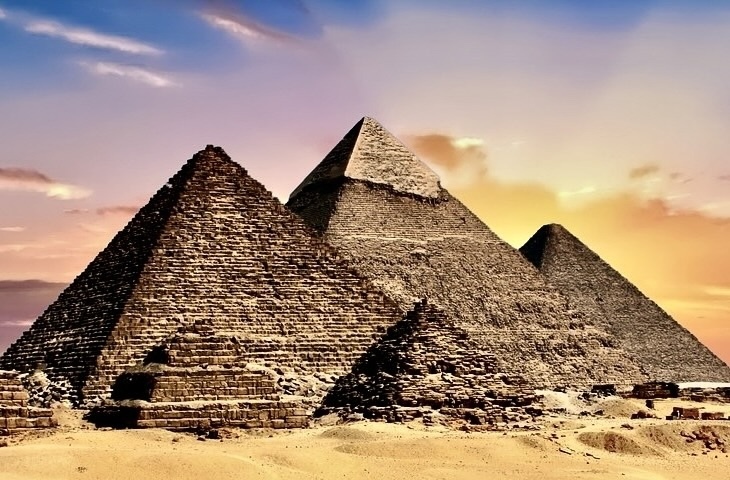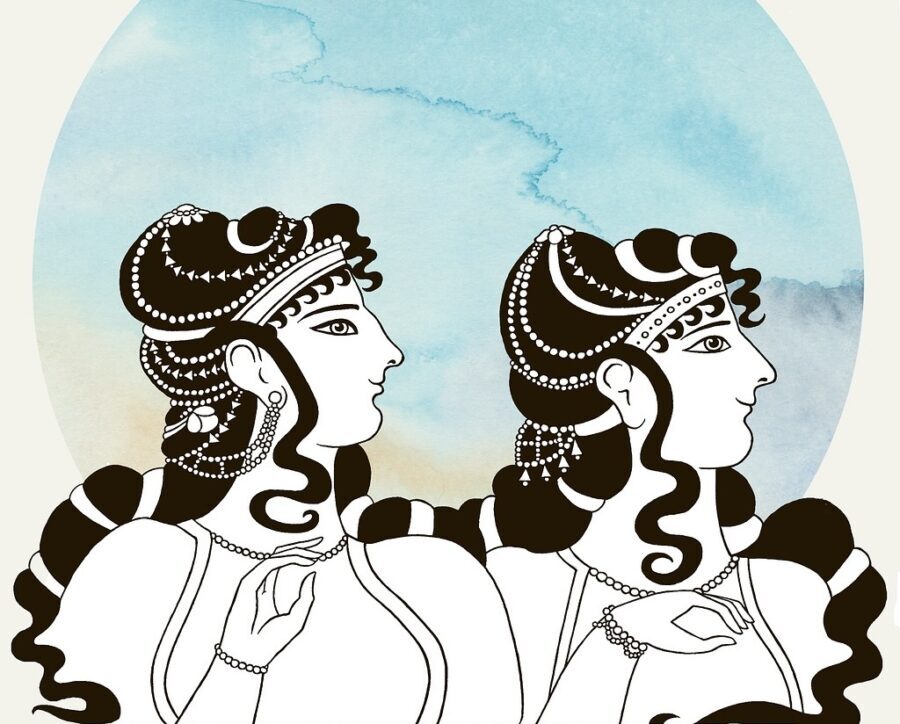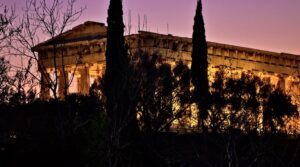
What follows is the latest in a series of interviews of Professor Paul Cartledge on some of the most iconic wonders of ancient Greece, published exclusively for Popular Archaeology Magazine.
RM (Richard Marranca): Adjacent to the Acropolis is the ancient Greek Agora: could you tell us something of what went on there, and why it is worth visiting today?
PC (Paul Cartledge): Agora means ‘place of gathering’. What the Athenians gathered to do here were politics and commerce. The space was filled with, on one hand, market stalls selling almost anything under the sun – fresh and dried produce, manufactured goods, sex, human slaves; and on the other hand, there were political buildings, such as the Council Chamber, lawcourts, and mint. Looming over it is a remarkably well-preserved temple, contemporary with the Parthenon, built in honor of the Olympian craftsman god Hephaestus. Originally, the Agora ground had also been used for graves, and over time many wells were built to tap and store water. Excavations by the American School of Classical Studies/Athens, ongoing since 1931, have unearthed both remarkable graves and grave goods, and a host of political objects (juror’s tokens, weights and measures, terracotta water-jars for measuring the time allowed to speakers in the courts, ostraca potsherds). All are brilliantly displayed in the Rockefeller-funded Agora Museum, which mimics a genuine ancient Stoa (Portico, rectangular colonnaded building) donated to the Athenians by King Attalus II of Pergamum (220-138 BCE) in northwest Anatolia.
________________________
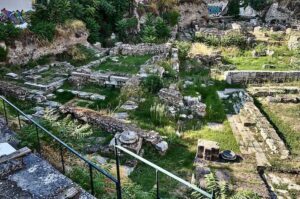
Current excavations of the north side of the ancient Athenian Agora. George E. Koronaios, CCO 1.0, Wikimedia Commons
________________________
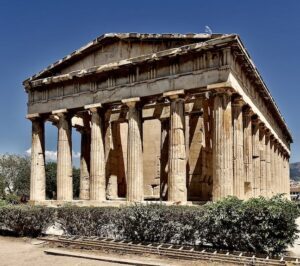
The Temple of Hephaestus. Jakub Hałun, CC BY 4.0, Wikimedia Commons
________________________
RM: The Kerameikos Cemetery – such a storied history. Wasn’t that where Pericles delivered the very famous Funeral Oration and where the Sacred Way (road to Eleusis) began? Can you unpack that a little?
PC: Kerameikos means Potters’ Quarter – whence our English word ‘ceramic’. Athens was blessed with exceptional claybeds nearby at Maroussi (ancient Amarousion) and an abundance of spring water to turn it in to potters’ clay. But the Quarter became even more famous as the location of Athens’s principal civic cemetery. This was indeed where Pericles in 431 BCE delivered one of his Funeral Orations (the one that’s given an approximate rendering by the contemporary Athenian historian Thucydides, who couldn’t of course reproduce it word for word). Like the Agora, the Kerameikos boasts an unbroken grave series going back into the prehistoric Late Bronze Age well before 1000 BCE. Like the Agora Museum, the Kerameikos Museum is a faithful record of what first German and then Greek archaeologists have uncovered there.
_________________________
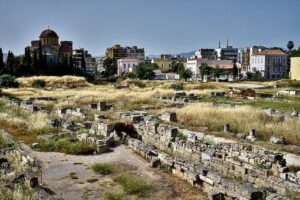
The Kerameikos Cemetery. George E. Koronaios, CC BY-SA 4.0, Wikimedia Commons
_________________________
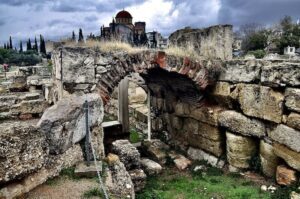
Kerameikos Cemetery. Paweł ‘pbm’ Szubert, CC BY-SA 3.0, Wikimedia Commons
_________________________
RM: Can you give us some of the highlights of the cemetery and who is buried there?
PC: The Kerameikos grave goods enable archaeologists and archaeohistorians such as myself to trace an unbroken evolution of style in painted pottery from prehistoric to early historic. Special mention must go to a quite recently discovered 6th-century BCE marble Sphinx. Originally a composite male figure (lion’s body, eagle’s wings, human head), the Sphinx was transgendered by the Greeks into a female monster no one wanted to have to tussle with (as Oedipus did – successfully). A bonus are the often elaborate grave monuments that can still be viewed in situ, for example that of the young Athenian cavalryman Dexileōs, who died fighting against Sparta near Corinth in 394; or the collective grave of the Spartans who died at Athens in 403, attempting unsuccessfully to keep Athens under the brutal control of a narrow anti-democrat regime later nicknamed ‘the 30 Tyrants’.
RM: Can you dig a little into the funerary practices of the Greeks?
PC: Greeks both inhumed (buried) and cremated their kindred dead. And as in the case of Pericles’s Funeral Oration, they also held collective, civic funeral ceremonies honoring the dead in war (their ashes placed in cedar coffins). The purpose of the funerary rites was twofold: both to ensure a safe passage for the dead persons down below the earth into Hades (Underworld) and to provide a site of memory at which relatives and later descendants could gather to pay their respects. Some exceptionally wealthy graves were powerful physical monuments, still visible today (above). Most were simple cists but usually containing grave goods to accompany the dead on their passage below. Commemorative ceremonies were performed at the grave – the pouring of a libation of oil or wine, the eating of a funeral feast – at fixed intervals after the burial. The ancient pagan Greeks had a sobering adage: call no one happy until you have seen how they died. A ‘good’ death was one that capped off a good life.
RM: Recently, you mentioned the newly opened museum in Thessaloniki. I haven’t been to Thessaloniki at all and would love to hear about it.
PC: The city of Thessaloniki, modern Greece’s second after Athens (though it took a century more for Thessaloniki to escape the Ottoman empire and join the modern Greek state), was founded originally in 315 BCE by the Macedonian warlord Cassander. He named it after his wife, a daughter of Philip II and so half-sister to Alexander the Great, whose own name celebrated Philip’s victory (nike) over the territory of Thessaly adjoining Macedonia on the south.
Thessaloniki boasts an excellent Archaeological Museum, which in 2026 is due to be joined at last by a huge Holocaust Museum commemorating the fact that until the 1940s, when they were systematically murdered by the occupying Nazis, the well over 50,000 Sephardic Jewish inhabitants amounted to almost half the city’s total population. The new, 2024 Museum is a museum of Thessaloniki’s 23 centuries but it is built down, not up – three of its levels are subterranean. Since Thessaloniki became Thessalonica after the Roman conquest, the Museum will also house part of that city’s main drag, the Decumanus Maximus, discovered when digging the city’s new metro train system. That dig yielded some 300,000 objects, and building the Museum cost 3 billion euros. Here begins the archaeological controversy: treasures were sliced horizontally and vertically before being stitched together again for display. That didn’t go down well with many professional Greek archaeologists.
__________________________
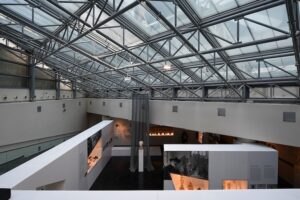
The Archaeological Museum of Thessaloniki. Herbert Frank from Wien (Vienna), AT, CC BY 2.0, Wikimedia Commons
__________________________

Gold diadem. Grave good from tombs at Sedes. 320-300 BC. Archaeological Museum of Thessaloniki. Tilemahos Efthimiadis, CC By-SA 2.0, Wikimedia Commons
__________________________
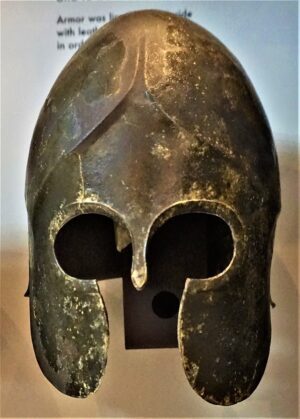
Macedonian Army Helmet – Archaeological Museum of Thessaloniki. Joyofmuseums, CC BY-SA 4.0, Wikimedia Commons
__________________________
RM: I recall the French archaeologist Théeophile Homolle who excavated in the late 1800s at Delphi. Can you give us some of the highlights about this breathtaking place and its oracle? From where did the Pythia (snake priestess) derive her power?
PC: Homolle (1848-1925) had first excavated on Delos in the 1870s before he as Director of the French School 1891-3 initiated the – continuing – French excavations on the site of Delphi. Looked at one way, Delphi was one ginormous war-memorial. Greeks alas didn’t fight only against non-Greeks — very much not, and several of the largest or most important monuments were dedicated at Delphi by one state as an in-your-face reply to another! I prefer not to think about that too much but to visit the superb newish Museum, in which one can find on show the most delicately painted wine-goblets and small bronze figurines alongside the armor and weapons stripped from enemies and dedicated permanently to Apollo. The oracular priestess of Apollo at Delphi wasn’t called the Pythia because she was in any way serpentine, but because the site as a whole was sometimes also known as ‘Pytho’; that title commemorating the huge python that in myth Apollo had slain in order to gain control of the numinous place.
_______________________
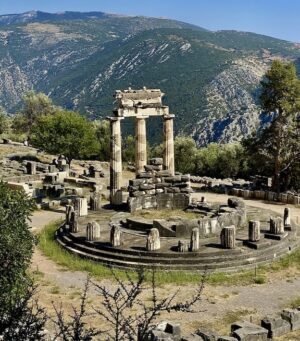
The place of the Oracle of Delphi. Patrocle, Pixabay
_______________________
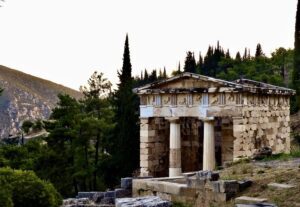
Temple of Delphi. Twalmedia, Pixabay
_______________________
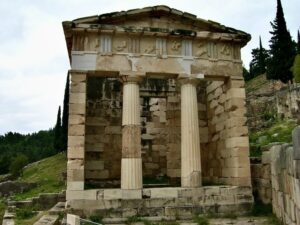
Temple of Delphi (facade details). russ101, Pixabay
_______________________
RM: Can we journey to Delos, which holds vast importance for myth and history? Can you mention a few highpoints — including the Delian League?
PC: Delos, like Delphi, is a ‘French site’, that is open exclusively to archaeologists sponsored by the French School. They have been doing astonishing work on this small (3.43 sq. kilometers) island at the heart of the Cyclades chain for over 150 years. Like Delphi, Delos was sacred to Apollo – but not only to him. His twin sister Artemis, born with him to Leto actually on the island, shared the veneration. Unlike Delphi, though, Delos was relatively inaccessible, and from time to time external powers took measures to make it even more so.
Of all those foreign powers the most successful was Athens, which established an annual Delia festival involving sending a sacred mission from Athens to perform religious rituals on the island. In the 5th century indeed the Athenians made Delos the spiritual as well as mundane heart of a new multistate, anti-Persian alliance, the so-called ‘Delian League’. Much of the island’s agricultural land was then directly administered by special Athenian officials called amphictyons. Visitors to the island will be immediately struck by a terrace of 9-12 7th-century BCE marble lions (the best Greek marble came from two other Cycladic islands, Naxos and Paros) arranged beside a Sacred Way, echoing that of Delphi. An early Hymn to Apollo manages to combine his links to both Delos and Delphi in one poem.
_______________________
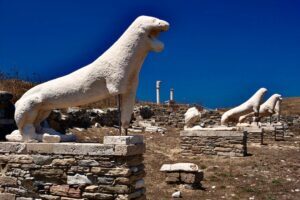
Terrace of the Lions, Delos island, Cyclades, Greece. User:Ggia, CC BY-SA 3.0, Wikimedia Commons
_______________________
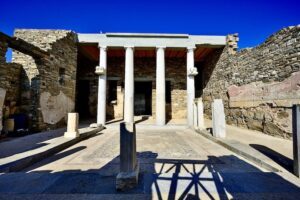
House of Trident in the Theatre Quarter on Delos. Zde, CC BY-SA 4.0, Wikimedia Commons
_______________________
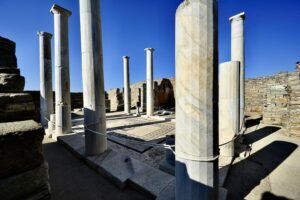
House of Dionysus on Delos. Zde, CC BY-SA 4.0, Wikimedia Commons
_______________________
RM: Can you highlight some of what’s in the museum?
PC: The Delos Museum, first opened in 1904, has just reopened after a period of closure for renovation. The sculpture hall is a sight to see. As is the marble statue-group of North Wind god Boreas abducting (probably a euphemism) Oreithyia, a daughter of Athens’s mythical founding king Erechtheus, in order to make her his wife. (Marriage by rape was a regular feature of ancient Greek mythology.) An Athenian work of the end of the 5th century BCE, the group originally formed an acroterion of the Temple of the Athenians: a combined figure perched atop one of the Temple’s two pediments for all to see from afar.
_______________________
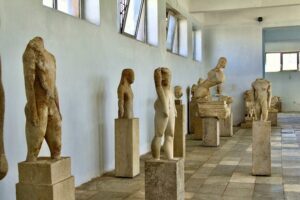
The left front part of the first hall of archaic statues, view from the entrance. Museum of Delos. Zde, CC BY-SA 3.0, Wikimedia Commons
_______________________
RM: Last year, we had our Olympics interview in Popular Archaeology. Can we revisit this place, including what’s left of the physical location?
PC: Olympia, sacred to Zeus of Mount Olympus (rising over 10,000 feet high in Macedonia, north Greece), was, unlike Delphi, an exclusively religious site and space. It lay out of the way in northwest Peloponnese, and not very near to a convenient port (Kyllene). So exactly how it came to be as famous and indispensable as it had become by the 8th century BCE and remained so for the next 14 centuries remains a bit of a puzzle… As already mentioned, the Olympic Games were locked into a Circuit of games festivals, but the Olympics were the first and always the most important of the four. Zeus had a consort, possibly a rival, in his sister-wife Hera, whose temple is actually earlier than Zeus’s, which was not built until the 450s.
By then the Games had been held every four years for at least 250 years. (The official date of the first Olympics is what we call 776 BCE, but only one event was then staged, the 200 meter dash, and that remained the sole event until 720.) Absolutely everything that the Greeks did in the sphere of either religion or athletics anywhere at any time is represented, in spades, at Olympia. Sadly the site was vulnerable to earthquakes and floods, which eventually obliterated it, but from the 1870s – same time as and in rivalry with the French School – the German Archaeological Institute began the campaigns of excavation, reconstruction, and interpretation that they continue to this day.
Not to be missed within the most sacred part of the site, the Altis grove, is of course the Stadium. The horse-race course lay elsewhere and hasn’t yet been properly rediscovered. The Games consisted of just 9 events, men only, though women might own the horses or chariots that competed in the Hippodrome. For all events the prize (there was only one – no silver or bronze medals) was just an olive wreath – there were no value-prizes awarded at any of the Circuit Games.
Like Delphi, Olympia too was a gigantic war-memorial site; and as at Delphi the Olympia Archaeological Museum (there’s a separate museum of the modern, revived post-1896 Games) is stuffed with arms and armor, made of bronze and iron. But especially stunning are the remains of the large and imposing Zeus Temple made of local limestone – sadly, the gold-and-ivory cult-statue made in the 430s by Athenian craftsman Pheidias, one of the 7 Wonders of the Ancient world, has long since disappeared.
____________________________
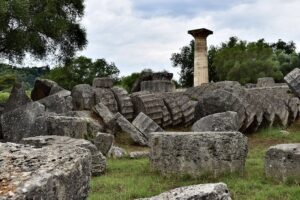
Remains of the Temple of Zeus in Olympia. Annatsach, CC BY-SA 4.0, Wikimedia Commons
____________________________
About Professor Paul Cartledge
Dr. Paul Cartlege is the author of Ancient Greece: A History in Eleven Cities; Alexander the Great; Democracy: A Life; The Spartans, and many other books. He is a familiar presence on BBC programs, including In Our Time and many others. He was chief historical consultant for the BBC TV series The Greeks and the Channel 4 series The Spartans presented by Bettany Hughes. Receiving his DPhil from the University of Oxford, he is now emeritus Leventis Professor of Greek Culture at the University of Cambridge and Leventis SRF at Clare College.
He is Commander of the Order of Honour of Greece, an Honorary Citizen of Sparta, and Vice-Chair of the British Committee for the Reunification of the Parthenon Marbles.
____________________________
Cover Image, Top Left: Temple of Hephaestus. AndreasKyttaro (Andreas Androutsellis-Theotokis), CC BY-SA 4.0, Wikimedia Commons
____________________________
Advertisement
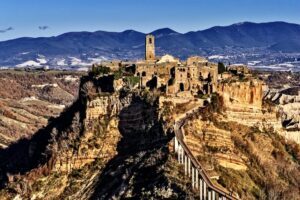
EXPLORE THE ANCIENT ETRUSCANS IN PERSON!
Experience a unique, up-close-and-personal hike among ancient hilltop towns in central Italy. You will walk the sensational countryside of the regions of Umbria and Tuscany, soaking in important sites attesting to the advanced Etruscan civilization, forerunners of the ancient Romans; imposing architectural and cultural remains of Medieval Italy; local food and drink; and perhaps best of all — spectacular scenic views! Join us in this collaborative event for the trip of a lifetime!

